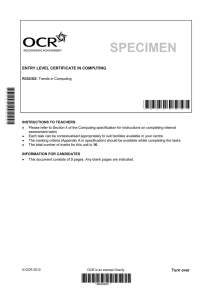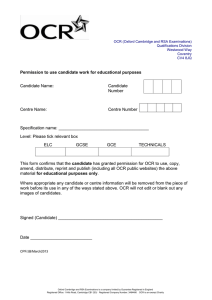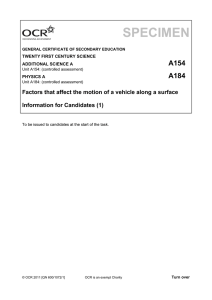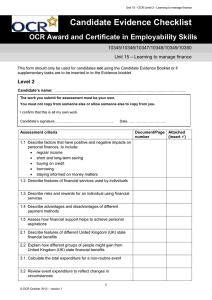Unit B763 - Controlled assessment
advertisement
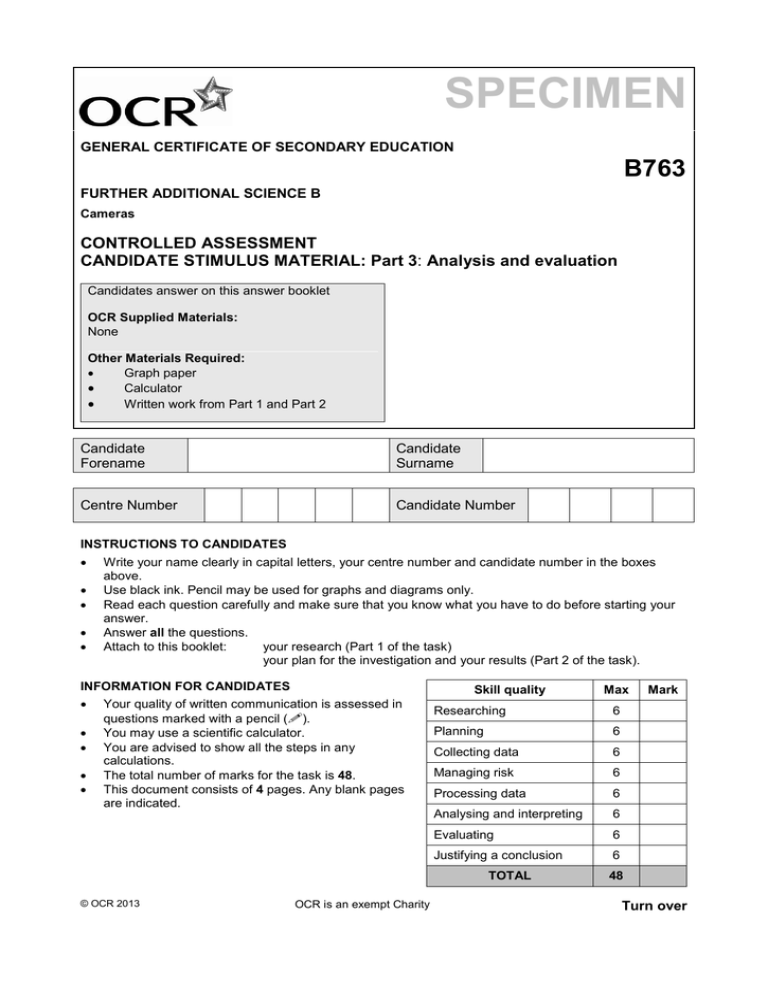
SPECIMEN GENERAL CERTIFICATE OF SECONDARY EDUCATION B763 FURTHER ADDITIONAL SCIENCE B Cameras CONTROLLED ASSESSMENT CANDIDATE STIMULUS MATERIAL: Part 3: Analysis and evaluation Candidates answer on this answer booklet OCR Supplied Materials: None Other Materials Required: • Graph paper • Calculator • Written work from Part 1 and Part 2 Candidate Forename Candidate Surname Centre Number Candidate Number INSTRUCTIONS TO CANDIDATES • • • • • Write your name clearly in capital letters, your centre number and candidate number in the boxes above. Use black ink. Pencil may be used for graphs and diagrams only. Read each question carefully and make sure that you know what you have to do before starting your answer. Answer all the questions. Attach to this booklet: your research (Part 1 of the task) your plan for the investigation and your results (Part 2 of the task). INFORMATION FOR CANDIDATES • • • • • Skill quality Your quality of written communication is assessed in questions marked with a pencil (). You may use a scientific calculator. You are advised to show all the steps in any calculations. The total number of marks for the task is 48. This document consists of 4 pages. Any blank pages are indicated. Researching 6 Planning 6 Collecting data 6 Managing risk 6 Processing data 6 Analysing and interpreting 6 Evaluating 6 Justifying a conclusion 6 TOTAL © OCR 2013 OCR is an exempt Charity Max Mark 48 Turn over 2 Cameras When a convex lens is used to form a real image on a screen the distance between the object and the lens affects the distance between the lens and the place where the image is in focus. 1 Process the data you have collected and plot a graph(s) to show the results of your investigation. 2 Describe any patterns or trends in your results. Comment on any unexpected results. .......................................................................................................................................................... .......................................................................................................................................................... .......................................................................................................................................................... .......................................................................................................................................................... .......................................................................................................................................................... .......................................................................................................................................................... 3 Compare results of your own investigation (Part 2) with the data from other groups and any information you found in your research (Part 1). Suggest and explain reasons for any similarities and differences. .......................................................................................................................................................... .......................................................................................................................................................... .......................................................................................................................................................... .......................................................................................................................................................... .......................................................................................................................................................... .......................................................................................................................................................... © OCR 2013 SPECIMEN 3 4 Evaluate your results, the methods you used and how well you managed the risks. .......................................................................................................................................................... .......................................................................................................................................................... .......................................................................................................................................................... .......................................................................................................................................................... .......................................................................................................................................................... .......................................................................................................................................................... .......................................................................................................................................................... .......................................................................................................................................................... .......................................................................................................................................................... .......................................................................................................................................................... .......................................................................................................................................................... .......................................................................................................................................................... .......................................................................................................................................................... .......................................................................................................................................................... .......................................................................................................................................................... 5 Do your results from Part 2 support the hypothesis you suggested? Explain your answer. .......................................................................................................................................................... .......................................................................................................................................................... .......................................................................................................................................................... .......................................................................................................................................................... .......................................................................................................................................................... © OCR 2013 SPECIMEN Turn over 4 6 ‘Fixed-focus’ cameras are designed to produce sharp images of most objects, without the need to make any adjustments. These cameras cannot, however, be used to produce a clear photograph of objects that are close to the camera. Use the results from your investigation and your research to describe evidence that does or does not support this statement. Use relevant scientific explanations in your answer. .......................................................................................................................................................... .......................................................................................................................................................... .......................................................................................................................................................... .......................................................................................................................................................... .......................................................................................................................................................... .......................................................................................................................................................... .......................................................................................................................................................... .......................................................................................................................................................... .......................................................................................................................................................... .......................................................................................................................................................... Copyright Information: Permission to reproduce items where third-party owned material protected by copyright is included has been sought and cleared where possible. Every reasonable effort has been made by the publisher (OCR) to trace copyright holders, but if any items requiring clearance have unwittingly been included, the publisher will be pleased to make amends at the earliest possible opportunity. OCR is part of the Cambridge Assessment Group. Cambridge Assessment is the brand name of University of Cambridge Local Examinations Syndicate (UCLES), which is itself a department of the University of Cambridge. © OCR 2013 SPECIMEN
